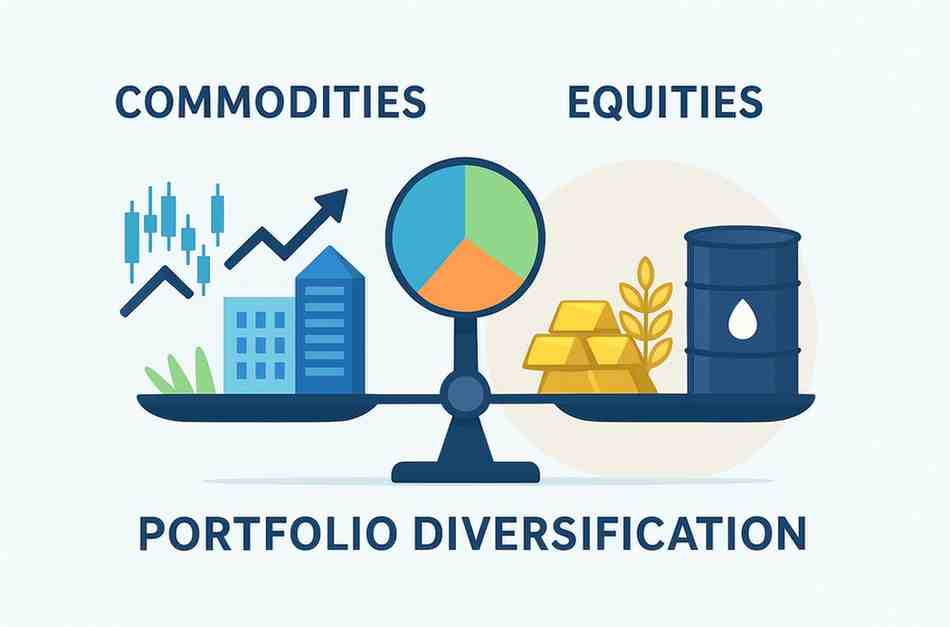
Why Commodities and Equities Work Together in Portfolio Diversification
Why Commodities and Equities Work Together in Portfolio Diversification
Diversification is a fundamental principle in investing, often referred to as a way to reduce risk and maintain balance in a portfolio. While equities form the backbone of most investment strategies, commodities add a distinct layer of stability and risk management. By understanding how both asset classes interact, investors can create more resilient portfolios that perform across different market conditions. This blog explores the commodities and equities diversification strategy, their correlation, and their combined role in portfolio risk management.
The Need for Portfolio Diversification
Market cycles in India and globally demonstrate that no single asset class performs consistently across all periods. Equities may generate higher returns during economic expansions, but they also come with volatility during downturns. Commodities, on the other hand, often move differently from equities and can protect portfolios against inflationary pressures or geopolitical risks.
This complementary movement forms the basis of an effective investment diversification with commodities and equity markets, helping investors maintain balance and avoid overdependence on one asset class.
Role of Commodities in Portfolio Diversification
The role of commodities in portfolio diversification lies in their ability to act as a hedge. Commodities like gold, silver, and crude oil tend to rise during periods of high inflation or market uncertainty. For instance, when equity markets in India experience corrections due to global volatility, gold prices often trend upward, cushioning overall portfolio losses.
Key roles commodities play include:
- Inflation hedge: Commodities often gain when inflation reduces the value of money.
- Risk offset: They may perform differently from stocks during economic stress.
- Global exposure: Investing in commodities links portfolios to global supply-demand dynamics beyond the Indian economy.
Combining Commodities and Equities for Risk Management
An effective way of combining commodities and equities for risk management is to balance growth-oriented equity exposure with the defensive qualities of commodities.
- Equities provide long-term growth potential through capital appreciation and dividends.
- Commodities act as a stabilizer during times of volatility or when inflationary pressures rise.
This strategy ensures that when one asset class underperforms, the other can potentially offset the downside. For example, equity markets may face volatility due to currency fluctuations or rising crude oil prices, while commodity investments could benefit from the same trend.
Benefits of Diversifying with Commodities and Equities
Investors considering the benefits of diversifying with commodities and equities should focus on how these assets complement one another.
- Reduced volatility: The low correlation between the two helps balance portfolio fluctuations.
- Protection against inflation: Commodities safeguard purchasing power when costs rise.
- Broader opportunity set: Exposure to multiple markets and sectors enhances return potential.
- Improved resilience: A blended allocation can help portfolios withstand varied economic conditions.
For Indian investors, where equity markets are often influenced by domestic and global factors, adding commodities can provide an additional safety net.
Practical Approaches for Indian Investors
Building a commodities and equities diversification strategy requires choosing the right instruments and allocation:
- Equities: Direct stock investments, equity mutual funds, or index funds focusing on Indian markets.
- Commodities: Gold ETFs, commodity-focused mutual funds, or futures contracts.
- Blended Funds: Some mutual funds and portfolio management services offer hybrid products that combine equity and commodity exposure.
Investors must align allocation with their risk appetite, investment horizon, and financial objectives. For instance, a conservative investor may allocate a higher percentage to gold ETFs, while a growth-focused investor may prioritize equities with limited commodity exposure.
Investment Diversification with Commodities and Equity Markets
In the context of India, investment diversification with commodities and equity markets has gained traction due to increasing accessibility. Exchanges such as NSE and BSE now offer commodity derivatives, while ETFs and mutual funds simplify access for retail investors.
With rising participation, investors are no longer confined to equities alone. Commodity exposure, particularly in gold, has emerged as a common strategy for maintaining portfolio stability during uncertain times.
Conclusion
The integration of commodities and equities provides a practical framework for building balanced portfolios. Equities drive long-term growth, while commodities offer protection during volatile or inflationary phases. By focusing on the commodities and equities diversification strategy, Indian investors can achieve a structured approach to risk management and steady wealth creation.
Ultimately, diversification is not about predicting which asset class will perform better but about ensuring that portfolios remain resilient across changing economic conditions. Combining the growth potential of equities with the defensive strength of commodities can help investors move closer to their financial goals while effectively managing risks.
Download the app today to start your trading journey on your Android device: (Download GigaPro Mobile App) or on your Apple device: (Download GigaPro Mobile App).
Related Blogs:
What is Sector Rotation and How Does it Work?
How to Implement Diversification for a Profitable Portfolio
Build a Stronger Investment Portfolio Through Diversification
Diversification Strategies: Combining Commodities and Equities
Diversification Strategies: Why Spreading Your Risk Matters
How to Use Sector Rotation to Diversify Your Portfolio
Why Diversification Strategies Matter for Managing Investment Risk
Why Trade Commodities? Harnessing Diversification and Inflation Hedge Potential
How Do Asset Allocation and Diversification Work Together?
How to Diversify Your Portfolio with Commodities: A Strategic Approach
Building an All-Weather Portfolio for the Indian Investor Integrating Equities, Bonds, and Commodities
The Rising Appeal of Commodities for Indian Investors
Commodity Trading: Key Strategies for Risk Management and Informed Decisions
Disclaimer: This blog post is intended for informational purposes only and should not be considered financial advice. The financial data presented is subject to change over time, and the securities mentioned are examples only and do not constitute investment recommendations. Always conduct thorough research and consult with a qualified financial advisor before making any investment decisions.
